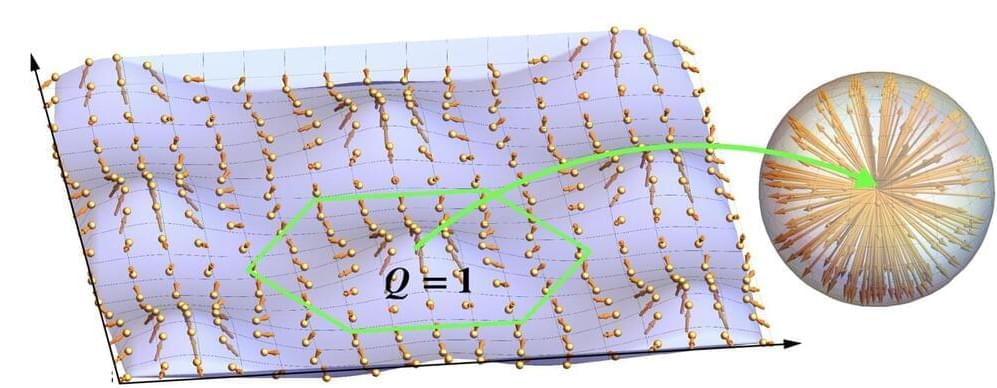We introduce Genie, a foundation world model trained from Internet videos that can generate an endless variety of playable (action-controllable) worlds from synthetic images, photographs, and even sketches.



Topological wave structures are wave patterns that exhibit specific topological properties, or in other words, properties that remain unvaried under smooth deformations of a physical system. These structures, such as vortices and skyrmions, have attracted significant attention within the physics research community.
While physicists have carried out extensive studies focusing on topological wave structures in various wave systems, surprisingly their most classical example remains unexplored. These are water waves, oscillations or disturbances that propagate on the surface of water or other fluid.
Researchers at RIKEN recently set out to fill this gap in the literature, by offering a description of various water-wave topological structures. Their paper, published in Physical Review Letters, offers a theoretical framework that could inform future experiments aimed at emulating topological wave phenomena.

Cybersecurity company Cybereason reveals that the actual price of a ransomware attack on a business includes much more than the ransom itself.
When choosing whether to comply and pay the demanded ransom to cyber attackers, there are many different considerations to have in mind. The latest report by Cybereason reveals that only one in two victims who paid ransom actually got their data back uncorrupted, and four out of five were eventually breached again by the same attackers.
According to Cybernews, the company’s researchers went over 1,008 IT professionals who all dealt with breachers at least once in the past two years and found that 84% chose to pay the ransom, averaging $1.4 million in the US. However, only 47% got their data and services back uncorrupted, so this doesn’t appear to have been the optimal strategy.

Tesla took half the awards for brand loyalty in the automotive industry in S&P Global Mobility’s new study.
Once you go electric, you don’t go back.
Studies have shown that electric vehicle buyers generally don’t go back to gasoline vehicles.

When analyzing the all-electric vehicle (EV) market, we have noticed that the segment shifted towards all-wheel-drive (AWD) powertrains. The front-wheel-drive (FWD) and rear-wheel-drive (RWD) models are in the minority.
It wasn’t always like that though. Between 2010 and 2013, there were only single-motor FWD and RWD models on the market. Things changed in the 2014 model year when Tesla introduced a dual-motor AWD version of the Model S (85D).
In the 2015 model year, Tesla expanded the dual-motor family to a few versions (about a quarter of all versions on the market, at the time), and then doubled the AWD lineup with the newly launched Model X in the 2016 model year.


Chayka argues that cultivating our own personal taste is important, not because one form of culture is demonstrably better than another, but because that slow and deliberate process is part of how we develop our own identity and sense of self. Take that away, and you really do become the person the algorithm thinks you are.
As Chayka points out in Filterworld, algorithms “can feel like a force that only began to exist … in the era of social networks” when in fact they have “a history and legacy that has slowly formed over centuries, long before the Internet existed.” So how exactly did we arrive at this moment of algorithmic omnipresence? How did these recommendation machines come to dominate and shape nearly every aspect of our online and (increasingly) our offline lives? Even more important, how did we ourselves become the data that fuels them?
These are some of the questions Chris Wiggins and Matthew L. Jones set out to answer in How Data Happened: A History from the Age of Reason to the Age of Algorithms. Wiggins is a professor of applied mathematics and systems biology at Columbia University. He’s also the New York Times’ chief data scientist. Jones is now a professor of history at Princeton. Until recently, they both taught an undergrad course at Columbia, which served as the basis for the book.


A team led by former Twitter engineers is rethinking how AI can be used to help people process news and information. Particle.news, which entered into private beta over the weekend, is a new startup offering a personalized, “multi-perspective” news reading experience that not only leverages AI to summarize the news, but also aims to do so in a way that fairly compensates authors and publishers — or so is the claim.
While Particle hasn’t yet shared its business model, it arrives at a time when there’s a growing concern about the impact of AI on a rapidly shrinking news ecosystem. News that is summarized by AI could limit clicks to publishers’ websites, which means their ability to monetize via advertising would also be reduced.
The startup was founded last year by former Senior Director of Product Management at Twitter, Sara Beykpour, who worked on products like Twitter Blue, Twitter Video, and conversations, and who spearheaded the experimental app, twttr. She had been at Twitter from 2015 through 2021, growing her position from software engineering to that of a senior director of product management. Her co-founder is a former senior engineer at both Twitter and Tesla, Marcel Molina.

Figure AI, a startup developing human-like robots, is reportedly in the process of raising $675 million in funding, with a pre-money valuation of roughly $2 billion.
Among the investors are Jeff Bezos’ Explore Investments, Microsoft, Nvidia and an Amazon-affiliated fund, Bloomberg reported Friday (Feb. 23), citing unnamed sources.
Other backers include Intel ’s venture capital arm, LG Innotek, Samsung ’s investment group, Parkway Venture Capital, Align Ventures, ARK Venture Fund, Aliya Capital Partners, Tamarack, Boscolo Intervest and BOLD Capital Partners, according to the report.